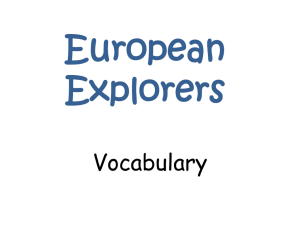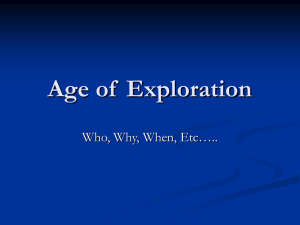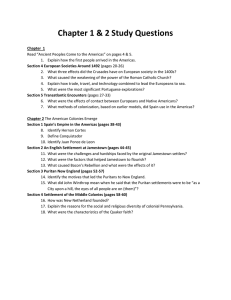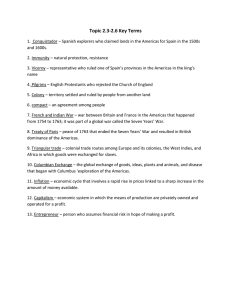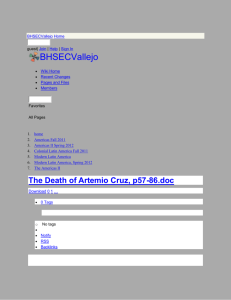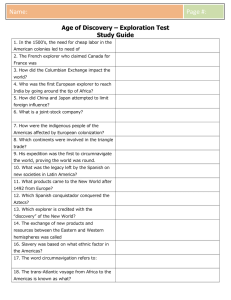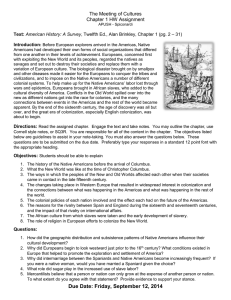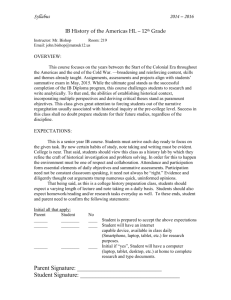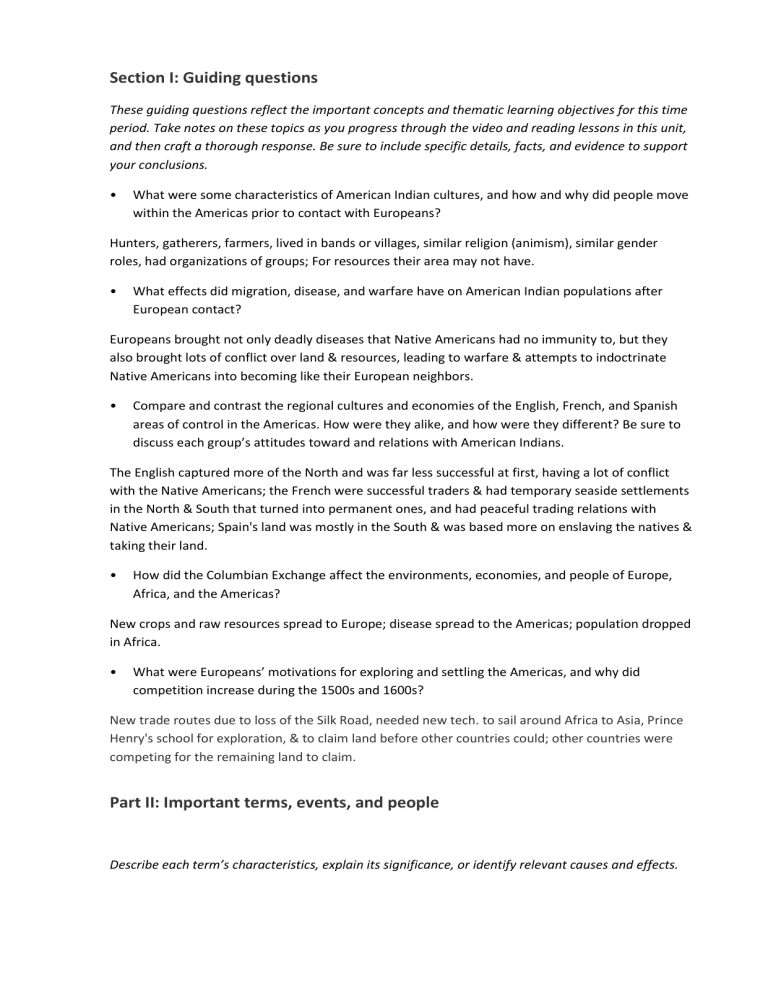
Section I: Guiding questions These guiding questions reflect the important concepts and thematic learning objectives for this time period. Take notes on these topics as you progress through the video and reading lessons in this unit, and then craft a thorough response. Be sure to include specific details, facts, and evidence to support your conclusions. • What were some characteristics of American Indian cultures, and how and why did people move within the Americas prior to contact with Europeans? Hunters, gatherers, farmers, lived in bands or villages, similar religion (animism), similar gender roles, had organizations of groups; For resources their area may not have. • What effects did migration, disease, and warfare have on American Indian populations after European contact? Europeans brought not only deadly diseases that Native Americans had no immunity to, but they also brought lots of conflict over land & resources, leading to warfare & attempts to indoctrinate Native Americans into becoming like their European neighbors. • Compare and contrast the regional cultures and economies of the English, French, and Spanish areas of control in the Americas. How were they alike, and how were they different? Be sure to discuss each group’s attitudes toward and relations with American Indians. The English captured more of the North and was far less successful at first, having a lot of conflict with the Native Americans; the French were successful traders & had temporary seaside settlements in the North & South that turned into permanent ones, and had peaceful trading relations with Native Americans; Spain's land was mostly in the South & was based more on enslaving the natives & taking their land. • How did the Columbian Exchange affect the environments, economies, and people of Europe, Africa, and the Americas? New crops and raw resources spread to Europe; disease spread to the Americas; population dropped in Africa. • What were Europeans’ motivations for exploring and settling the Americas, and why did competition increase during the 1500s and 1600s? New trade routes due to loss of the Silk Road, needed new tech. to sail around Africa to Asia, Prince Henry's school for exploration, & to claim land before other countries could; other countries were competing for the remaining land to claim. Part II: Important terms, events, and people Describe each term’s characteristics, explain its significance, or identify relevant causes and effects. animism- spiritual beliefs that center on the natural world. Mississippi Valley culture- some societies developed mixed agricultural and hunter-gatherer economies along the Mississippi river. Eastern Woodland culture- east of the Mississippi river, prospered with a rich food supply. matriarchal- a gendered power structure in which social identity and property descend through the female line. Pueblo culture- SW location, adobe villages, four language families, maize, squash, beans. patriarchy- a gendered power structure in which social identity and property descend through the male line and male heads of family rule over women and children. primogeniture- the practice of passing family land, by will or by custom, to the eldest son. peasant- the tradition term for farmworkers in Europe. the Reformation- the reform movement that began in 1517 with Martin Luther's critiques of the Roman Catholic Church and that precipitated and enduring schism that divided Protestants from Catholics. Calvinism- set of beliefs that the Puritans followed; simple worship, strict morals, pre-destination and hard work. predestination- the Protestant Christian belief that God chooses certain people for salvation before they are born. Portuguese exploration- the Portuguese were a main player in forming and discovering the modern world; in charge of African slave trade. feudalism- social system that existed in Europe during the Middle Ages in which people worked and fought for nobles who gave them protection and the use of land in return. This system was transferred to the Americas during colonization. capitalism- system of economic production based on the private ownership of property and the contractual exchange for profit of goods, labor, and money. plantation-based agriculture- production system based on a large estate owned by an individual, family, or corporation and organized to produce a cash crop. Spanish exploration- Spain owed its success to conquistadores, sent ships loaded with gold and silver, made Spain richest nation in Europe, other nations went to America to seek same riches. Bartolomé de Las Casas- Spanish missionary who was disgusted and outraged by the poor treatment of Native Americans especially the encomienda system.
